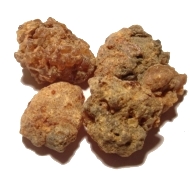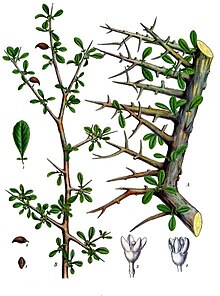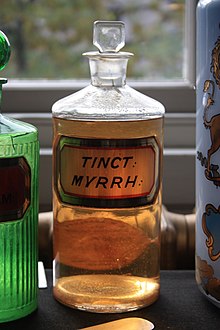| This article's lead section may be too short to adequately summarize the key points. Please consider expanding the lead to provide an accessible overview of all important aspects of the article. (March 2024) |

Myrrh (/mɜːr/; from an unidentified ancient Semitic language, see § Etymology) is a gum-resin extracted from a few small, thorny tree species of the Commiphora genus, belonging to the Burseraceae family. Myrrh resin has been used throughout history in medicine, perfumery, and incenses. Myrrh mixed with posca or wine was widely used in many ancient cultures to produce pleasurable feelings and as an anti-inflammatory and analgesic.
Extraction and production

When a wound on a tree penetrates through the bark and into the sapwood, the tree secretes a resin. Myrrh gum, like frankincense, is such a resin. Myrrh is harvested by repeatedly wounding the trees to bleed the gum, which is waxy and coagulates quickly. After the harvest, the gum becomes hard and glossy. The gum is yellowish and may be either clear or opaque. It darkens deeply as it ages, and white streaks emerge.
Myrrh gum is commonly harvested from trees of the genus Commiphara. It is commonly extracted from the species Commiphora myrrha, Commiphora africana, Commiphora erythraea, Commiphora gileadensis, Commiphora habessinica, Commiphora hodai, Commiphora guardricincta, Commiphora schimperi and Commiphora truncata.
Commiphora myrrha is native to Somalia, Oman, Yemen, Eritrea, Somali Region of Ethiopia and parts of Saudi Arabia. Meetiga, a trade name for Arabian myrrh, is brittler and gummier than the Somali variety and does not have the latter's white markings.
Liquid myrrh, or stacte, which was written about by Pliny, was formerly a greatly valued ingredient and is commercially available as Jewish Incense.
Etymology
The word myrrh corresponds to a common Semitic root m-r-r meaning "bitter", as in Arabic مُرّ murr and Aramaic ܡܪܝܪܐ mureera. Its name entered the English language by way of the Hebrew Bible, in which it is called מור mor, and also later as a Semitic loanword. It appears in numerous pre-Hellenic sources up to the translation of the Tanakh into the Septuagint, and later makes its way into the Greek myth about Myrrha; in the Ancient Greek language, the related word μῠ́ρον (múron), likely derived from a Semitic source, became a general term for perfume.
Attributed medicinal properties

| This section needs more reliable medical references for verification or relies too heavily on primary sources. Please review the contents of the section and add the appropriate references if you can. Unsourced or poorly sourced material may be challenged and removed. Find sources: "Myrrh" – news · newspapers · books · scholar · JSTOR (August 2015) |  |

In pharmacology, myrrh has been used as an antiseptic in mouthwashes, gargles, and toothpastes. It has also been used in liniments and salves applied to abrasions and other minor skin ailments. Myrrh has been used as an analgesic for toothache pain and in liniments applied to bruises, aching muscles, and sprains.
Myrrh gum has often been claimed to reduce the symptoms of indigestion, ulcers, colds, cough, asthma, respiratory congestion, arthritis, and cancer, although more good scientific evidence is needed to support these uses. There is evidence to suggest certain compounds in myrrh interact with central opioid pathways in the brain.
Religious ritual
In Ancient Egypt and Punt (Horn of Africa)
The fifth-dynasty ruler of Egypt, King Sahure, recorded the earliest attested expedition to the land of Punt, the modern day Horn of Africa (particularly Somalia), whose members brought back large quantities of myrrh, frankincense, malachite and electrum. The expedition also brought back wild animals (particularly cheetahs), a secretary bird (Sagittarius serpentarius), giraffes and Hamadryas baboons (which were sacred to the Ancient Egyptians), ebony, ivory and animal skins. In a relief from his mortuary temple celebrating the success of this expedition, Sahure is shown tending a myrrh tree in the garden of his palace. The relief, entitled "Sahure's splendor soars up to heaven", is the only one in Egyptian art that depicts a king gardening. Myrrh was used by the ancient Egyptians, along with natron, for the embalming of mummies.
In the Hebrew Bible

Myrrh is mentioned as a rare perfume in several places in the Hebrew Bible. In Genesis 37:25, the traders to whom Jacob's sons sold their brother Joseph had "camels ... loaded with spices, balm, and myrrh," and Exodus 30:23–25 specifies that Moses was to use 500 shekels of liquid myrrh as a core ingredient of the sacred anointing oil.
Myrrh was an ingredient of Ketoret: the consecrated incense used in the First and Second Temples at Jerusalem, as described in the Hebrew Bible and Talmud. An offering was made of the Ketoret on a special incense altar and was an important component of the temple service. Myrrh is also listed as an ingredient in the holy anointing oil used to anoint the tabernacle, high priests and kings.
Oil of myrrh is used in Esther 2:12 in a purification ritual for the new queen to King Ahasuerus:
Now when every maid's turn was come to go in to king Ahasuerus, after that she had been twelve months, according to the manner of the women, (for so were the days of their purifications accomplished, to wit, six months with oil of myrrh, and six months with sweet odours, and with other things for the purifying of the women).
In ancient Nabataea
Myrrh was recorded in the first century BC by Diodorus Siculus to have been traded overland and by sea via Nabatean caravans and sea ports, which transported it from Southern Arabia to their capital city of Petra, from which it was distributed throughout the Mediterranean region.
In the New Testament
Myrrh is mentioned in the New Testament as one of the three gifts (with gold and frankincense) that the magi "from the East" presented to the Christ Child (Matthew 2:11). Myrrh was also present at Jesus' death and burial. Jesus was offered wine and myrrh at his crucifixion (Mark 15:23). According to John's Gospel, Nicodemus and Joseph of Arimathea brought a 100-pound mixture of myrrh and aloes to wrap Jesus' body (John 19:39). The Gospel of Matthew relates that as Jesus went to the cross, he was given vinegar to drink mingled with gall: and when he had tasted thereof, he would not drink (Matthew 27:34); the Gospel of Mark describes the drink as wine mingled with myrrh (Mark 15:23).
In contemporary Christianity
Because of its mention in the New Testament, myrrh is an incense offered during some Christian liturgical celebrations (see Thurible). Liquid myrrh is sometimes added to egg tempera in the making of icons. Myrrh is mixed with frankincense and sometimes more scents and is used in the Eastern Orthodox, Oriental Orthodox, traditional Roman Catholic, and Anglican/Episcopal churches.
Myrrh is also used to prepare the sacramental chrism used by many churches of both Eastern and Western rites. In the Middle East, the Eastern Orthodox Church traditionally uses oil scented with myrrh (and other fragrances) to perform the sacrament of chrismation, which is commonly referred to as "receiving the Chrism".
In Islam
According to the hadith of Muhammad, narrated by Abu Nuaim on the authority of Abban bin Saleh bin Anas, Muhammad said, "Fumigate your houses with mugwort, myrrh and thyme." (Kanz-ul-Ummal). The Encyclopedia of Islamic Herbal Medicine mentions the same hadith: "The Messenger of Allah stated, 'Fumigate your houses with al-shih, murr, and sa'tar.'" The author states that this use of the word "murr" refers specifically to Commiphora myrrha. The other two are Al-Shih (possibly mugwort) and Sa'tar (or Za'atar - thyme).
Ancient myrrh
Pedanius Dioscorides described the myrrh of the first century AD as most likely to refer to a "species of mimosa", describing it "like the Egyptian thorn". He describes its appearance and leaf structure as "spinnate-winged".
Other products that can be confused with myrrh
The oleo-gum-resins of a number of other Commiphora species are also used as perfumes, medicines (such as aromatic wound dressings), and incense ingredients. These myrrh-like resins are known as bdellium (including guggul and African bdellium), balsam (balm of Gilead or Mecca balsam) and opopanax (bisabol).
Fragrant "myrrh beads" are made from the crushed seeds of Detarium microcarpum, an unrelated West African tree. These beads are traditionally worn by married women in Mali as multiple strands around the hips.
The name "myrrh" is also applied to the potherb Myrrhis odorata, otherwise known as "cicely" or "sweet cicely".
See also
Notes
- Another commonly used name, Commiphora molmol, is now considered a synonym for Commiphora myrrha.
References
- Rice, Patty C., Amber: Golden Gem of the Ages, Author House, Bloomington, 2006 p.321
- Pliny the Elder (1855) . "15: Wines Drunk by the Ancient Romans". The Natural History. Vol. 14. Translated by Bostock, John; Riley, Henry Thomas. London: H.G. Bohn. p. 253. ISBN 978-0-598-91078-3.
- Caspar Neumann, William Lewis, The chemical works of Caspar Neumann, M.D.,2nd Ed., Vol 3, London, 1773 p.55
- Göttsch, Eggert (1986). "TRADITIONAL AROMATIC AND PERFUME PLANTS IN CENTRAL ETHIOPIA (A botanical and ethno-historical survey)". Journal of Ethiopian Studies. 19: 81–90. ISSN 0304-2243. JSTOR 41965939.
- Pliny the Elder with Bostock, John and Riley, Henry Thomas, trans. (1855) The Natural History of Pliny. London, England, UK: Henry G. Bohn. vol. 3, Book 12, Chapters 33–35, pp. 129–132. From Ch. 35, p. 130: "The tree spontaneously exudes, before the incision is made, a liquid which bears the name of stacte, and to which there is no myrrh that is superior."
- Klein, Ernest, A Comprehensive Etymological Dictionary of the Hebrew Language for Readers of English, The University of Haifa, Carta, Jerusalem, p.380
- "Species Information". www.worldagroforestrycentre.org. Archived from the original on 2011-09-30. Retrieved 2009-01-15.
- "ICS-UNIDO – MAPs". www.ics.trieste.it. Archived from the original on 2011-08-09. Retrieved 2009-01-16.
- "Myrrh - Uses, Side Effects, and More". WebMD: Natural Medicines Comprehensive Database Consumer Version. Retrieved 2024-02-22.
- Al Faraj, S (2005). "Antagonism of the anticoagulant effect of warfarin caused by the use of Commiphora molmol as a herbal medication: A case report". Annals of Tropical Medicine and Parasitology. 99 (2): 219–20. doi:10.1179/136485905X17434. PMID 15814041. S2CID 2097777.
- Dolara, Piero (1996-01-04). "Analgesic effects of myrrh" (PDF). Nature. 379 (6560): 29. Bibcode:1996Natur.379...29D. doi:10.1038/379029a0. PMID 8538737.
- S.Wachsmann, (2008) "Seagoing Ships & Seamanship in the Bronze Age Levant" - Page 19
- Fritze, Ronald H. "New worlds: The great voyages of discovery 1400-1600". Sutton Publishing Limited, 2002, p. 25.
- J. W. Eadie, J. P. Oleson (1986) "The Water-Supply Systems of Nabatean and Roman Ḥumayma", Bulletin of the American Schools of Oriental Research
- Myrrh ~ مر مكي
- Morrow, Joh A. "Encyclopedia of Islamic Herbal Medicine". Jefferson, N.C.: McFarland, 2011, p. 145.
- The visitor or monthly instructor. Religious Tract Society. 1837. pp. 35–. Retrieved 9 May 2013.
Further reading
- Massoud A, El Sisi S, Salama O, Massoud A (2001). "Preliminary study of therapeutic efficacy of a new fasciolicidal drug derived from Commiphora molmol (myrrh)". Am J Trop Med Hyg. 65 (2): 96–99. doi:10.4269/ajtmh.2001.65.96. PMID 11508399.
- Dalby, Andrew (2000). Dangerous Tastes: the story of spices. London: British Museum Press. ISBN 978-0-7141-2720-0. (US ISBN 0-520-22789-1), pp. 107–122.
- Dalby, Andrew (2003). Food in the ancient world from A to Z. London, New York: Routledge. ISBN 978-0-415-23259-3., pp. 226–227, with additions
- Monfieur Pomet (1709). "Abyssine Myrrh)". History of Drugs. Abyssine Myrrh
- The One Earth Herbal Sourcebook: Everything You Need to Know About Chinese, Western, and Ayurvedic Herbal Treatments by Ph.D., A.H.G., D.Ay, Alan Keith Tillotson, O.M.D., L.Ac., Nai-shing Hu Tillotson, and M.D., Robert Abel Jr.
- Abdul-Ghani, RA; Loutfy, N; Hassan, A (2009). "Myrrh and trematodoses in Egypt: An overview of safety, efficacy and effectiveness profiles". Parasitology International. 58 (3): 210–4. doi:10.1016/j.parint.2009.04.006. PMID 19446652. ( A good review on its antiparasitic activities) .
External links
- History of Myrrh and Frankincense (itmonline.org)
| Nativity of Jesus | ||||||||
|---|---|---|---|---|---|---|---|---|
| People |
|  | ||||||
| Place | ||||||||
| Gifts of the Magi | ||||||||
| Narratives |
| |||||||
| Related | ||||||||
| In culture | ||||||||
| Remembrances | ||||||||